Abstract
Field studies were conducted in north-eastern Iran in 2010 and 2011 to establish the critical period of weed interference in potato (Solanum tuberosum L.) and to investigate the effects of weed interference on weed biomass. The critical period for weed control in potato based on a 5% acceptable yield loss level was calculated by fitting logistic and Gompertz equations to relative yield data. Total dry biomass and total number of weeds increased as the duration of weed infestation increased. The beginning of the critical period for weed control was 19 days after potato emergence in both years. The end of the critical period for weed control in 2011 was 22 days after potato emergence, whereas in 2010 the beginning and end of the critical period for weed control occurred simultaneously. Tuber yields of potato were reduced by prolonged delays in weed removal in both years. The practical implication of this study is that weeds must be controlled during the first 3 weeks of the crop's growing season. Such an approach would keep yield loss levels below 5%.
Introduction
Potato (Solanum tuberosum L.) is the fourth most important crop and the most important non-cereal food crop in the world, cultivated in many countries in different climatic zones, including temperate, tropical and subtropical regions (Lang Citation2001). Potato tubers contain valuable nutrients such as carbohydrates, proteins and various amino acids (Lisinska & Leszcynski Citation1989). High yielding capacity and better quality are considered the two main objectives in potato production. Weed invasion reduces both quality and quantity of potato tubers through decreasing size, weight and number of tubers (Arnold et al. Citation1997). Weeds compete with crops for nutrients, soil moisture and sunlight by covering over crops and taking up space. Severity of yield loss depends on weed infestation, duration of infestation and climatic conditions, which affect weed and crop growth (Rao Citation2000). Like many other crops, potato is very sensitive to weed interference over the main period of the growing season. A long period of time between planting, emergence and open canopy of potato reduces its ability to compete with weeds (Eberlein et al. Citation1997). According to Baziramakenga & Leroax (Citation1994) and Ivany (Citation1986), inadequate weed control in potato causes 20%–80% tuber yield loss. Therefore, effective and proper weed control during the growing season is of crucial importance in obtaining high tuber yield. Potato growers commonly use pre-emergence and post-emergence herbicides in order to control weeds in potato fields. Application of metribuzine as a pre-emergence herbicide, a week after planting, and removing weeds once more with inter-row cultivation or hand hoeing is quite common for weed control in potato-growing areas in Iran (Ahmadvand et al. Citation2009). These techniques are labour intensive, time consuming and they are not always successful or cost effective. Since a considerable cost of production is allocated to weed control, production techniques should be designed to decrease herbicide applications in order to guard against weed resistance and environmental damage (Hall et al. Citation1992). On the other hand, sustainable agriculture and health concerns, as well as increasing demands for ecologically produced crops, have encouraged farmers to seek alternative methods that reduce or eliminate synthetic herbicide use (Baumann et al. Citation2000). Many weed specialists suggest the implementation of an integrated weed management (IWM) system as a good alternative in reducing the amount of herbicide used while still maintaining crop yield (Swanton & Weise Citation1991). Nevertheless, substantial scientific reports are now available that show that the time of weed control is as important as the weeding itself. Delayed weeding until late stages could result in irreversible damage due to weed competition (Zimdahl Citation1987). The critical period of weed control (CPWC) is an integral part of an IWM programme and is defined as a period in the crop growth cycle during which weed control could be effectively carried out to prevent economic yield losses due to weed interference (Martin et al. Citation2001). There have been many critical period studies conducted on a variety of crops that define the critical period of weed control as representing the time interval between two components. The first component is the maximum length of time that weeds are left in the crop before they reduce crop yield. The second component is the period of time that the crop must be kept weed-free to maintain maximum yield so that weeds emerging later do not reduce yield (Swanton & Weise Citation1991; Van Acker et al. Citation1993; Baziramakenga & Leroax Citation1994; Wiliams Citation2006). Studying CPWC is helpful in identifying the timing of weed control and in achieving efficient herbicide use from both biological and economic aspects. Critical period consideration will also help to set an integrated approach involving chemical, cultural and mechanical methods that provide an effective weed control system in potato (Cruse et al. Citation1995). With regard to species-specific differences in morphology, physiology and development, the CPWC is likely to be unique for every crop. In addition, environmental factors such as climate, weed population density, dominant weeds in the region and crop-planting date can affect CPWC (Martin et al. Citation2001; Seem et al. Citation2003). Therefore, several studies have been carried out to determine CPWC in different crops under various climatic conditions (Dawson Citation1977; Buchanan et al. Citation1980; Rogers & Buchanan Citation1986; Bryson Citation1990; Van Acker et al. Citation1993; Knezevic et al. Citation2002; Evans et al. Citation2003).
Baziramakenga & Leroax (Citation1994) reported that to achieve 90% of highest tuber yield, the maximum time permitted for weeds to grow after potato emergence was 15 days, and the same level of tuber yield could be obtained if the crop was kept free of weeds from its emergence until 23–68 days. Ciuberkis et al. (Citation2007) showed that the CPWC in potato began at time of planting until 25 days after flowering. However, due to the variations in climatic conditions and weed flora, the results of other studies conducted in different environments or various crops may not apply to other systems. Hence, the objectives of the present study were to determine the critical period for weed control in potato under conditions found in Iran and to investigate the effect of weed interference on potato yield. The results of the present study could help potato producers to improve the efficiency of their current weed management systems and reduce yield loss resulting from weed competition.
Materials and methods
Site description
A field experiment was conducted for two consecutive growing seasons during 2010 and 2011 at the agriculture research centre of Shahrood, Semnan (Iran) located at 36°25′N latitude and 55°01′E longitude with an altitude of 1345 m above sea level. Based on meteorological statistics, annual rainfall is 180 mm with a mean annual air temperature of 14 °C. The local climate is semi-arid, subtropical with hot, dry summers and cold winters. The soil texture was a clay loam with a bulk density of 1.4 g cm−3 and a pH of 7.9. This region is one of the major potato-producing regions of Iran. Soil preparation was conducted according to local practices for potato production. The soil was ploughed using a mould-board plough and then disked twice before tuber planting. No pre-emergence or pre-plant herbicides were used. According to the local soil test recommendations, a basal dose of 350 kg N (urea) ha−1 at two stage of potato growth (planting and 1 week before tuber formation) in equal portions and 40 kg Mg ha−1 and 50 kg Cu ha−1 at planting stage, were incorporated into the soil. In order to prevent soil-borne disease, potato tubers were treated with fungicide Mankozeb at the rate of 0.8% (wt/wt) before planting. Potato tubers (cv. Agria) were hand drilled in the middle of May in both years in eight rows spaced 75 cm apart in each plot and 8 m long. A plant-to-plant distance of 25 cm was maintained in each plot. All plots were irrigated using a furrow method based on a local calendar, in which the experimental land was irrigated at intervals of 15 days from crop planting until 30 June and at intervals of 10 days thereafter.
Experimental design
The experimental design was a randomized complete block with four replications. To determine the critical period of weed control, a quantitative series of treatments comprising two components were applied: (1) increasing duration of weed interference; and (2) increasing length of weed-free period. Timing of weed removal was based on the number of days after crop emergence. In order to evaluate the onset of the critical period of weed removal, the first component—increasing duration of weed interference—was established by delaying weed control from the time of crop emergence until 10, 20, 30 and 40 days after crop emergence (DAE), after which plots were maintained weed-free until harvest. To determine the end of the critical period, the second component—increasing length of weed-free period—was established by maintaining weed control from the time of emergence until the above-presented time before allowing subsequent emerging weeds to remain for the rest of the season. In addition, weed control and weed-free control treatments were included in the experiments.
Weed and crop measurements
Natural, mixed weed species populations were used to determine CPWC for general weed interference. The weed community was composed of four species in both 2010 and 2011. The dominant weeds observed in 2010 were Amaranthus blitoides, Acroptilon repens, Chenopodium album and Setaria viridis, and in 2011 were Amaranthus blitoides, C. album, Echinochloa crus-galli and Convolvulus arvensis. Weed infestations were assessed at the end of each treatment by classifying weed plants in two areas per plot using a 1.0 × 1.0 m quadrat. In order to determine weed dry weight, the above-ground portion of weeds were clipped at the soil surface in these quadrats, dried at 75° C for 48 h and weighed. In order to record final tuber yield, an area 2 m long, corresponding to the central area of the middle three rows of each plot, was hand-harvested at maturity. In order to calculate tuber yield, tuber weight per plant and number of plants per unit area were recorded and potato tuber yield calculated using EquationEquation (1):
Data analysis
To determine the critical period of weed control, equations describing crop yield response to weed interference were fitted to the potato yield data using a non-linear regression procedure (Curve Expert V1.3). The Gompertz equation (Martin et al. Citation2001) was used to describe the effect of increasing duration of weed-free period on potato tuber yield (EquationEquation 2):
A logistic equation (Mulugeta & Boerboom Citation2000) was used to describe the effect of increasing duration of weed infestation on the tuber yield of potato (EquationEquation 3):
Determination of the CPWC in this study was based on yield loss levels of 5% chosen arbitrarily by producers because of its economic relevance to the cost of weed control.
Results and discussion
Weed and crop measurements
The weed community was composed of eight species in both 2010 and 2011. In 2010, the major weed species were Amaranthus blitoides, S. viridis and Chenopodium album, accounting for 35%, 22.6% and 20.8%, respectively, of the total density, whereas the major weed species in 2011 were E. crus-galli and Acroptilon repens, accounting for 24.73% and 17.6%, respectively, of the total density. In 2010, E. crus-galli was also presented but at a lower density than in 2011. Weed species such as Malcolmia africana, S. viridis, Vaccaria oxyodonta and Convolvulus arvensis were presented only in 2010, and Amaranthus retroflexus, Acroptilon repens, Sonchus oleraceus and Polygonum aviculare were presented only in 2011 by total, and marketable categories were different in each year. Weed density measured at 130 DAE was 69 plants m−2 and 173 plants m−2 in 2010 and 2011, respectively (). Differences in the weed composition and density between the years can be attributed to the use of different experimental sites and management practices in previous crop.
Table 1 Weed composition and their average densities (plant m−2) in unweeded control, measured at the crop harvest in 2010 and 2011 growing seasons.
Total weed dry biomass in both years decreased with increasing duration of the weed-free period. Weed-free periods of 20 DAE resulted in weed dry matter reduction of 83% and 88% in 2010 and 2011, respectively (). A similar pattern was observed in weed numbers—increasing duration of weed-free periods significantly decreased the number of weeds m−2 in both years. Weed-free periods of 20 DAE decreased the number of weeds by 79% and 62% in 2010 and 2011, respectively (). This phenomenon is in agreement with Thakral et al. (Citation1989) and Ahmadvand et al. (Citation2009) who stated that the total dry weight and the number of weeds in potato crops were the highest in the unweeded control.
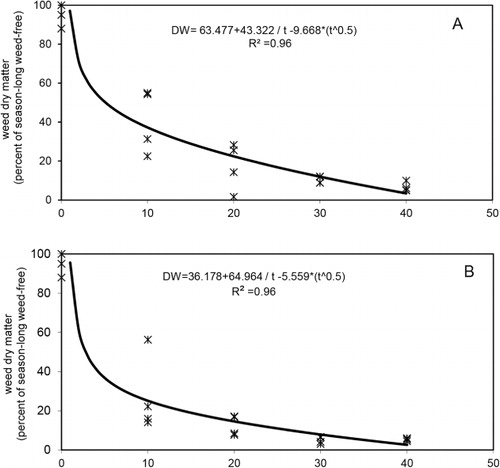
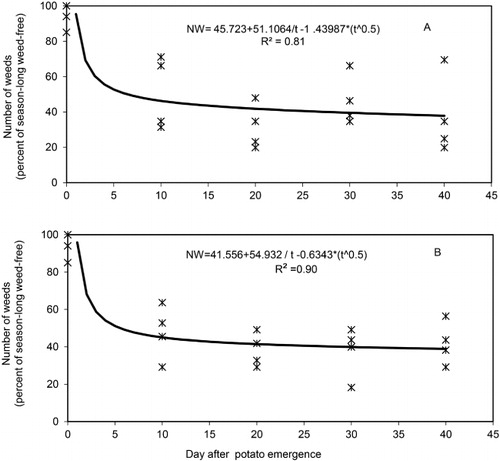
Both potato tubers weight per plant and tuber yield of potato were reduced by prolonged delays in weed removal in both years. Conversely, potato tubers weight and tuber yield of potato increased with increasing duration of weed-free period in both years ( and ). A significant decrease in potato tuber yield may be explained by interference from Chenopodium album and Amaranthus blitoides in 2010 and E. crus-galli, Chenopodium album and Convolvulus arvensis in 2011. During the period 7–20 DAE, these weeds overshadowed the potato plants and covered the soil surface, thus competing with the potato plants for light, water and minerals. This competition effect seemingly resulted in a reduction of photosynthesis, which suppressed the growth and biomass accumulation rate and consequently caused poor potato production. The lower tuber yield in 2011 can be attributed to the higher weed density compared with 2010. Decrease in crop performance with increasing duration of weed interference has been reported by some researchers working on potato (Thakral et al. Citation1989; Ahmadvand et al. Citation2009) and other crops (Amador-Ramirez Citation2002; Bukun Citation2004; Mohammadi et al. Citation2004).
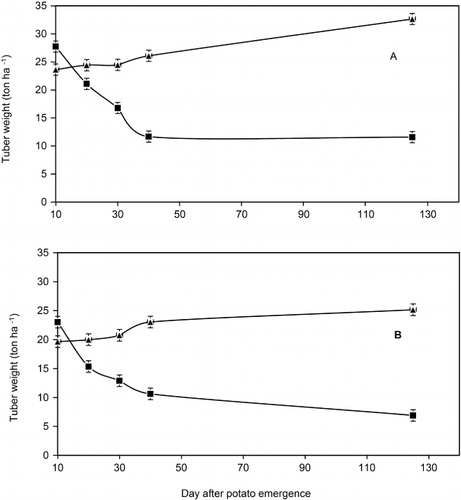
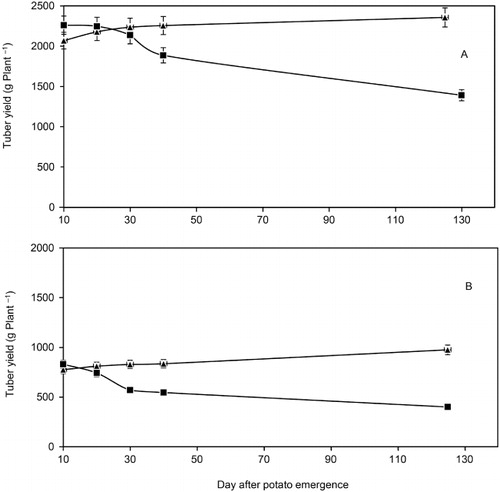
Yield responses and critical period of weed control
Since a significant interaction between year and weed competition levels was observed (data not shown), relative data were not pooled across the year. Instead, parameters for logistic and Gompertz equations were calculated for each year ( and ) and differences between the onset and end of the CPWC were tested by year. Predicted and observed relative potato tuber yields, as affected by duration of the weed-infested or weed-free periods, are shown in . Responses were highly significant (as identified by the R2 values) in both years (; and ). In 2010, the beginning and end of CPWC based on 5% acceptable yield loss (AYL) occurred by 19 DAE. Prior to these stages, weed presence did not significantly affect the potato tuber yield. This can be related to the lack of serious competition between the potato and the weeds in acquiring common environmental resources before these stages. Other authors have reported a critical period of weed control for potato, from 2 to 4 weeks after emergence (Ivany Citation1984) to 9 weeks after planting (Saghir & Markoullis Citation1974). This difference might be explained by variations in environmental conditions, weed population, weed species, soil moisture, soil fertility and planting pattern (Swanton & Weise Citation1991). In 2011, the onset of CPWC at 5% AYL was 19 DAE, which was similar to 2010; however, the end of the CPWC occurred by 22 DAE. The earlier end of CPWC in 2010 could be attributed to the lower weed density (69 vs. 172 plant m−2) in that year compared with 2011. The relative time of weed and crop emergence and densities of both crop and weeds may explain the variation in the crop-weed interference relationship between years and location (Lindquist et al. Citation1999). According to Martin et al. (Citation2001), weed density is an important factor in the determination of CPWC. They observed that in oilseed (Brassica napus L.), the critical period tended to be later for experiments with lower weed density. A similar result was found by Hall et al. (Citation1992) in maize (Zea mays L.). Knezevic et al. (Citation2002) also reported that the critical period of weed interference for a given crop can be varied with the relative time of weed emergence. At low weed densities there may be no critical period of weed interference (Van Acker et al. Citation1993; Martin et al. Citation2001).
Table 2 Parameter values for tuber yield response curves based on logistic model:100 × Y = (1/(Dex (K(T − X)) + F) + ((F − 1)/F).
Table 3 Parameter values for tuber yield response curves based on Gomez model: Y = A exp (−B exp (−KT)).
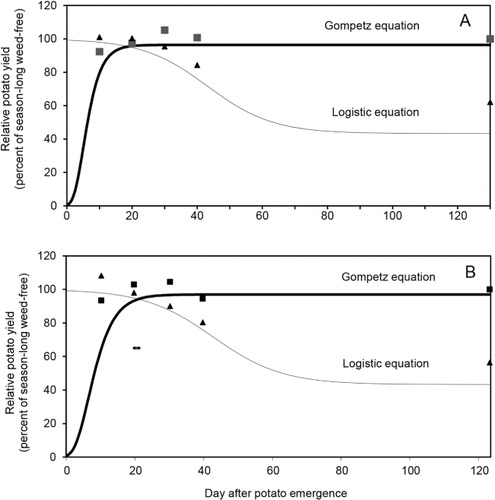
The development of any integrated weed management system requires knowledge of the weeds' behaviour in the field, including possible effects on crop yields. The approach of the CPWC is part of that understanding, which would allow for the development of strategies for integrated weed management. Based on the results of the present study, it can be concluded that weeds must be controlled during the first 3 weeks of potato growing seasons in order to prevent yield losses. The results of this study contribute to the development of an integrated weed management for cv. Agria in Shahrood. The definition of the critical period of weed control supports the early control of weeds using pre-emergence herbicides. Data obtained from this study provide a basis for potato producers to make a decision with respect to timely weed control measures, regardless of methodology.
References
- Ahmadvand G, Modani F, Golzardi F 2009. Effect of crop plant density on critical period of weed competition in potato. Scientia Horticulturae 121: 249–254. 10.1016/j.scienta.2009.02.008
- Amador-Ramirez MD 2002. Critical period of weed control in transplanted chili pepper. Weed Research 42: 203–209. 10.1046/j.0043-1737.2002.00278.x
- Arnold RN, Murray MN, Gregory EJ, Smeal D 1997. Weed control in field potatoes. Agricultural Experiment Station Research Report No. 723. Farmington, NM, College of Agriculture and Home Economics, New Mexico State University.
- Baumann DT, Kropff MJ, Bastiaans L 2000. Intercropping leeks to suppress weeds. Weed Research 40: 359–374. 10.1046/j.1365-3180.2000.00197.x
- Baziramakenga R, Leroax GD 1994. Critical period of quack grass (Elytrigia repens) removal in potatoes (Solanum tuberosum). Weed Science 42: 528–533.
- Bryson CT 1990. Interference and critical time of removal of hemp Sesbania (Sesbania exeltata) in cotton (Gossypium hirsutum). Weed Technology 4: 833–837.
- Buchanan GA, Crowley RH, Street JE, McGuire JA 1980. Competition of sicklepod (Cassia obtusifolia) and redroot pigweed (Amaranthus retroflexus) with cotton (Gossypium hirsutum). Weed Science 28: 258–262.
- Bukun B 2004. Critical period for weed control in cotton in Turkey. Weed Research 44: 404–412. 10.1111/j.1365-3180.2004.00415.x
- Ciuberkis S, Bernotas S, Raudonius S, Felix J 2007. Effect of weed emergence time and intervals of weed and crop competition on potato yield. Weed Technology 21: 612–617. 10.1614/WT-06-101.1
- Cruse D, Ampony N, Labrada R, Merago A 1995. Weed management in legume crops: bean, soybean and cowpea in ‘Weed management for development countries’. FAO Plant Production and Protection. Pp. 283–287.
- Dawson JH 1977. Competition of late-emerging weeds with sugar beets. Weed Science 25: 168–170.
- Eberlein CV, Patterson PE, Guttieri MJ, Stak JC 1997. Efficacy and economics of cultivation for weed control in potato (Solanum tuberosum). Weed Technology 11: 257–264.
- Evans SP, Knezevic SZ, Lindquist JL, Shapiro CA, Blankenship EE 2003. Nitrogen application influences the critical period for weed control in corn. Weed Science 51: 408–417. 10.1614/0043-1745(2003)051[0408:NAITCP]2.0.CO;2
- Hall MR, Swanton CJ, Anderson GW 1992. The critical period of weed control in grain corn (Zea mays). Weed Science 40: 441–447.
- Ivany JA 1984. Quackgrass (Agropyron repens) control in potatoes (Solanum tuberosum) with sethoxydim. Weed Science 32: 194–197.
- Ivany JA 1986. Quackgrass competition effect on potato yield. Canadian Journal of Plant Science 66: 185–187. 10.4141/cjps86-027
- Knezevic SZ, Evans SP, Blankenship EE, Van Acker RC, Lindquist JL 2002. Critical period for weed control: the concept and data analysis. Weed Science 50: 773–786. 10.1614/0043-1745(2002)050[0773:CPFWCT]2.0.CO;2
- Lang J ed. 2001. Notes of a Potato Watcher. Texas, USA, A & M University Press, 233 p.
- Lindquist JL, Mortensen DA, Westra P, Lambert WJ, Bauman TT 1999. Stability of corn (Zea mays)–foxtail (Setaria spp.) interference relationships. Weed Science 47: 195–200.
- Lisinska G, Leszcynski W 1989. Potato science and technology. New York, Elsevier Applied Science. 408 p.
- Martin SG, Van Acker RC, Friesen LF 2001. Critical period of weed control in spring canola. Weed Science 49: 326–333. 10.1614/0043-1745(2001)049[0326:CPOWCI]2.0.CO;2
- Mohammadi G, Javanshir A, Khooie FR, Mohammadi SA, Zehtab-Salmasi S 2004. Critical period of weed interference in chickpea. Weed Research 45: 57–63. 10.1111/j.1365-3180.2004.00431.x
- Mulugeta D, Boerboom CHM 2000. Critical time of weed removal in glyphosate-resistant Glycine max. Weed Science 48: 35–42. 10.1614/0043-1745(2000)048[0035:CTOWRI]2.0.CO;2
- Rao VS 2000. Principles of Weed Science. Enfield (NH), USA, Science Publishers, INC. 555 p.
- Rogers NK, Buchanan GA 1986. Influence of row spacing on weed competition with cotton. Weed Science 24: 410–414.
- Saghir AR, Marhoullis G 1974. Effects of weed competition and herbicides on yield quality of potatoes in British weed control conference, Proceedings… London: British Crop Protection Council. Pp. 533–539.
- Seem JE, Cramer NG, Monks DV 2003. Critical weed-free period for ‘Beauregard’ sweet potato (Ipomoea batatas). Weed Technology 17: 686–695. 10.1614/WT02-089
- Swanton CJ, Weise SF 1991. Integrated weed management: the rationale and approach. Weed Technology 5: 657–663.
- Thakral KK, Pandita ML, Khurana SC, Kaloo G 1989. Effect of time of weed removal on growth and yield of potato. Weed Research 29: 33–38. 10.1111/j.1365-3180.1989.tb00838.x
- Van Acker RC, Swanton CJ, Weise S 1993. The critical period of weed control in soybean (Glycine max (L.) Merr.). Weed Science 41: 194–200.
- Wiliams MM 2006. Planting date influences critical period of weed control in sweet corn. Weed Science 54: 928–933.10.1614/WS-06-005R.1
- Zimdahl RL 1987. The concept and application of the critical weed-free period. In: Altieri MA and Liebman M eds. Weed management in agro ecosystems: ecological approaches. Florida, USA, CRC Press, Inc. Pp. 145–156.
